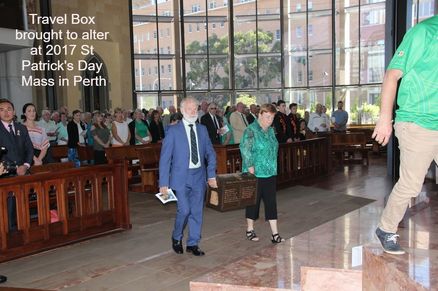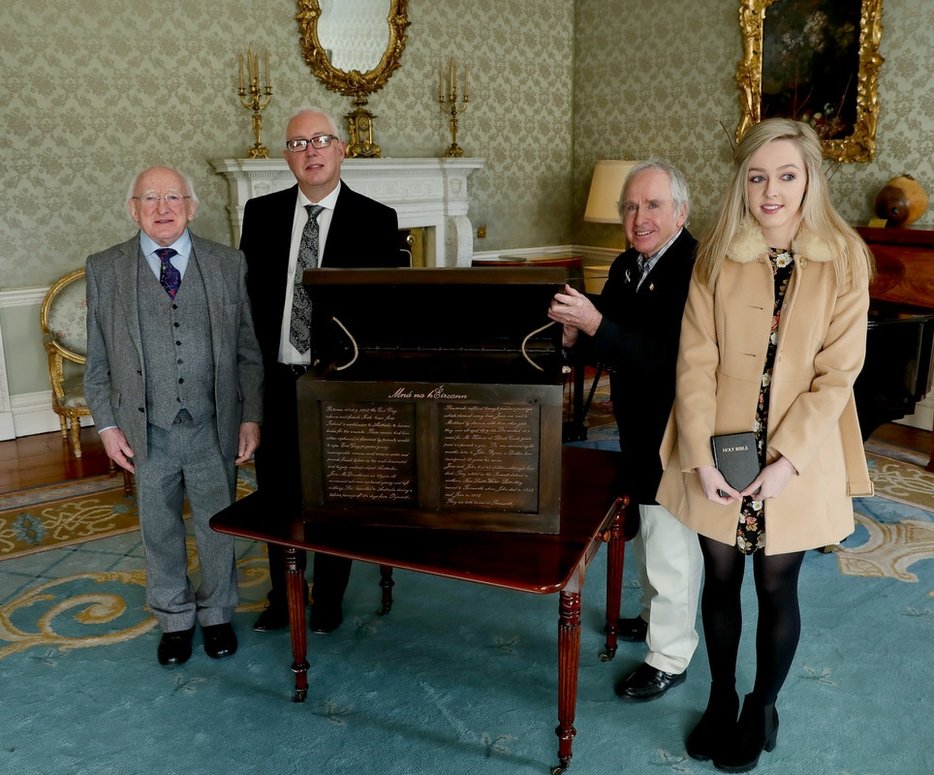the story of
FAMINE TRAVEL BOXES FOR COMMEMORATIONS
MADE BY IRISH PRISON SERVICES

At the beginning of 2015 the Irish Prison Service and Michael Blanch of the C.C.I.F.V. (the Committee for the Commemoration of Irish Famine Victims) came together to undertake a project called Famine Travel Boxes.
Michael has been campaigning for a national day of remembrance for famine victims for many years. He finally saw his efforts come to fruition in 2015 when the Irish government announced that the second Sunday in May will now become National Famine Memorial Day.
Because of the Famine many people became destitute and ended up in workhouses that were built in an effort to house the homeless and the needy.
Such was the number of people affected it became almost impossible to care for them all.
The Poor Law Union established in 1838 came into its own during and after the Great Famine. During these years upwards of 500,000 people left these shores to new lives all over the world.
The travel boxes were born from the idea that they symbolised emigrants and their travels to foreign shores to start new lives away from Ireland. They were given to women who went to Australia from workhouses all over the country. Made locally, or in the workhouses themselves, there are no original examples left in existence as far as we know. Because of this our boxes are an interpretation of those originals.
Women and young girls, some as young as ten or eleven, were encouraged to emigrate to Australia to seek new opportunities. This practice was known as Assisted Emigration.
The girls were provided with items of clothing made and paid for by the poor law unions. This made sure the girls would have a good start when they landed in their new country. The travel box contained all of their worldly possessions, and would ensure they arrived at their destinations in good order, and with enough clothing to start anew.
The first replicas were completed in September 2015, with Mountjoy Museum and the Carrickmacross Workhouse the initial recipients. A replica of the Castleblakney box has been sent to Western Australia, commissioned by the great grandson of Mary Ann Taylor, who left Galway in 1852 aged seventeen.
The Jeanie Johnston museum ship also received a box to commemorate those who emigrated to The United States and Canada aboard her.
Recently a miniature box was delivered to the United Nations in New York to form part of their display on the Famine. Each box is individual. Each one tells its own unique story of a person, a workhouse, a ship, and the journey undertaken by a person displaced from their home by forces outside their control.
The project will continue as long as we receive requests from interested museums, heritage centres etc. The only request we have is that the box is displayed in a public place where all can see it and the story it tells.
Michael has been campaigning for a national day of remembrance for famine victims for many years. He finally saw his efforts come to fruition in 2015 when the Irish government announced that the second Sunday in May will now become National Famine Memorial Day.
Because of the Famine many people became destitute and ended up in workhouses that were built in an effort to house the homeless and the needy.
Such was the number of people affected it became almost impossible to care for them all.
The Poor Law Union established in 1838 came into its own during and after the Great Famine. During these years upwards of 500,000 people left these shores to new lives all over the world.
The travel boxes were born from the idea that they symbolised emigrants and their travels to foreign shores to start new lives away from Ireland. They were given to women who went to Australia from workhouses all over the country. Made locally, or in the workhouses themselves, there are no original examples left in existence as far as we know. Because of this our boxes are an interpretation of those originals.
Women and young girls, some as young as ten or eleven, were encouraged to emigrate to Australia to seek new opportunities. This practice was known as Assisted Emigration.
The girls were provided with items of clothing made and paid for by the poor law unions. This made sure the girls would have a good start when they landed in their new country. The travel box contained all of their worldly possessions, and would ensure they arrived at their destinations in good order, and with enough clothing to start anew.
The first replicas were completed in September 2015, with Mountjoy Museum and the Carrickmacross Workhouse the initial recipients. A replica of the Castleblakney box has been sent to Western Australia, commissioned by the great grandson of Mary Ann Taylor, who left Galway in 1852 aged seventeen.
The Jeanie Johnston museum ship also received a box to commemorate those who emigrated to The United States and Canada aboard her.
Recently a miniature box was delivered to the United Nations in New York to form part of their display on the Famine. Each box is individual. Each one tells its own unique story of a person, a workhouse, a ship, and the journey undertaken by a person displaced from their home by forces outside their control.
The project will continue as long as we receive requests from interested museums, heritage centres etc. The only request we have is that the box is displayed in a public place where all can see it and the story it tells.
IRISH PRESIDENT PRESENTED WITH FAMINE TRAVEL BOX
In January 2017 the Irish Prison Service were honoured to be able to present one of our Famine Heritage Boxes to President Michael D. Higgins in Áras an Uachtaráin.
This represented a remarkable achievement for both the project itself, and for all involved.
To have the work carried out by the C.C.I.F.V. and the I.P.S. on this project recognised by the highest office in the land, is a source of great pride for all of us.
The box we presented to President Higgins depicted the story of thousands of young women and girls sent to Australia on the Earl Grey Scheme.
PICTURED L - R: President Michael D. Higgins, A.C.O. Mark O’Brien, Michael Blanch C.C.I.F.V, Emma O’Brien
Click below for PDF with the complete story of the Famine Travel Boxes
In January 2017 the Irish Prison Service were honoured to be able to present one of our Famine Heritage Boxes to President Michael D. Higgins in Áras an Uachtaráin.
This represented a remarkable achievement for both the project itself, and for all involved.
To have the work carried out by the C.C.I.F.V. and the I.P.S. on this project recognised by the highest office in the land, is a source of great pride for all of us.
The box we presented to President Higgins depicted the story of thousands of young women and girls sent to Australia on the Earl Grey Scheme.
PICTURED L - R: President Michael D. Higgins, A.C.O. Mark O’Brien, Michael Blanch C.C.I.F.V, Emma O’Brien
Click below for PDF with the complete story of the Famine Travel Boxes
| the_journey_magazine_march_2019.pdf | |
| File Size: | 1182 kb |
| File Type: | |
